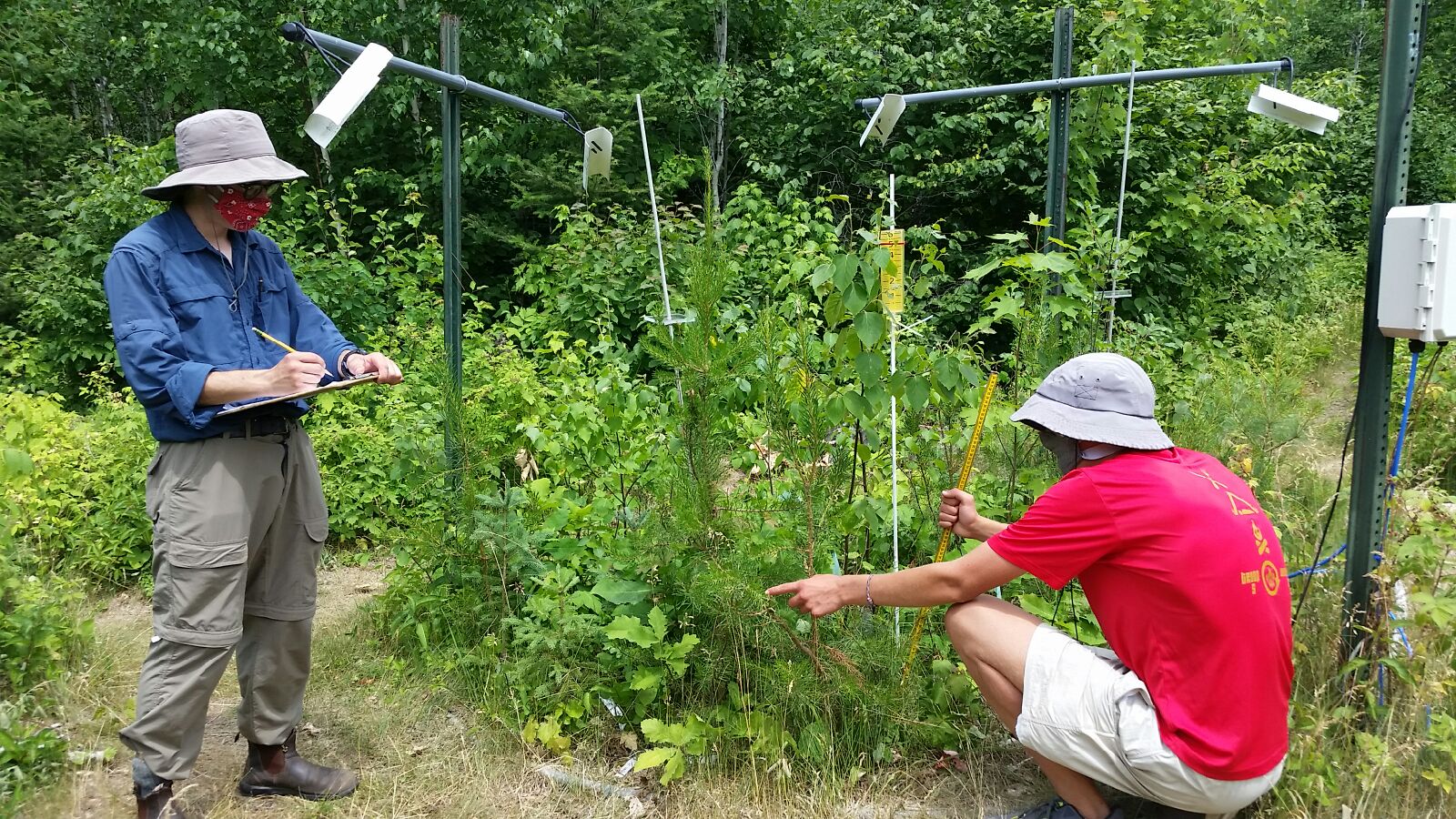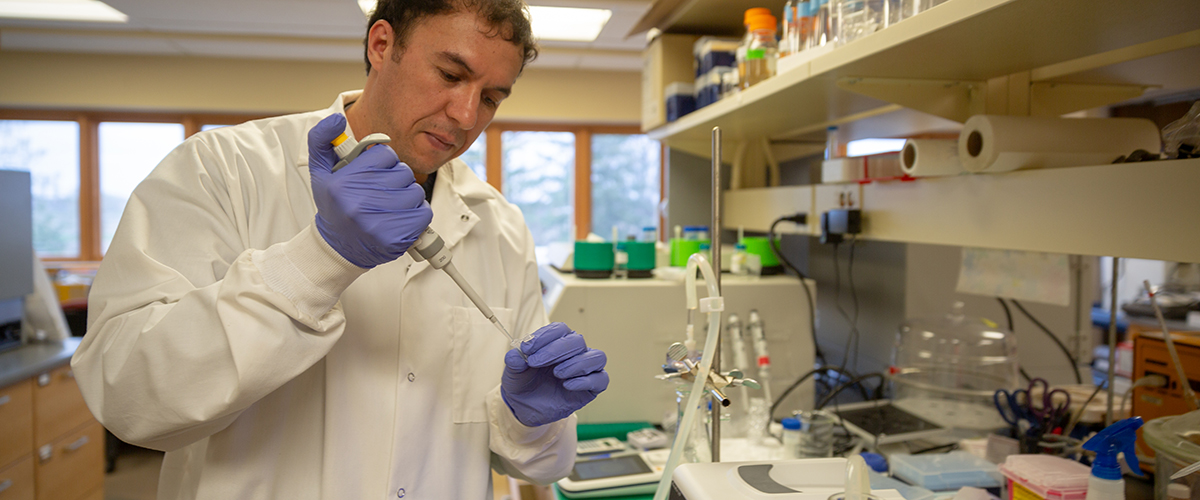How invasive species researchers are adapting to challenging times
August 3, 2020
The global pandemic has changed the way the world works. MITPPC-funded researchers have had to incorporate this change into their current projects in big ways. Ph.D. candidate Artur Stefanski, Associate Professor Abdennour Abbas, and undergraduate Research & Outreach Assistant Katie Connolly describe how their work has been affected by COVID-19.

Members of the B4Warmed team measure growth of woody invasives like buckthorn and honeysuckle in a temperature-controlled plot at the Cloquet research site. (Credit: Artur Stefanski)
Keeping long-term research going
Artur Stefanski and team – led by lead investigator ecologist Peter Reich – has invested $5 million and more than a decade of work into a project that aims to predict the future growth of buckthorn and honeysuckle as the climate warms. When the COVID-19 pandemic became a factor in early spring of this year, this project faced some challenges. The long-term format of this project made it imperative to continue research, even when COVID-19 was at its worst. CFANS allowed them to carry on with their research as long as they implemented CDC and University guidelines.
“I do think that, from our perspective as researchers, we are actually really good at following protocols. Because that's how we work. We always follow the protocol,” said Stefanski.
When travelling between the Twin Cities and the project’s experimental site in Cloquet, each researcher must take their own vehicle without any other passengers. Staggered schedules also allow researchers to divide their time and work safely away from each other. Finally, the team has adopted social distancing practices in addition to wearing masks.
“[Researchers] are actually really good at following protocols. Because that's how we work. We always follow the protocol."
“Our Cloquet site is actually probably the best place to work because we are outside, so it's easy to keep distance. And we are away from all other people. It could not be a better work setup,” said Stefanski.
There have been hiccups along the way. Early this year, the group ordered around 12,000 tree seedlings to be shipped from nurseries. Stefanski realized that, with the campus closed due to COVID-19, any seedlings shipped there would sit overnight and likely not survive. Thus began a zigzagging journey to personally track down the FedEx driver en route and intercept the important seedlings. He is hopeful they now have a better chance of survival.
“If it wasn’t for COVID, those packages would have gone to their originally scheduled locations, and everything would have been totally fine,” said Stefanski.
Stefanski is certain that good things will come out of these new challenges and ways of working, saying that many of the protocols that they have had to adapt will most likely stay for good. He explains that, through the process of coming up with these adaptations, they were able to figure out how to better their research as a whole.
“We learned how to do our research in a more flexible way. We learned how to accommodate.”
Stefanski also hopes for larger lessons to come from what humankind has experienced through this pandemic.
“I hope we all, as humans, learn something from this and become better at preventing the potential next pandemic,” he said. “Hopefully this will help us unite a little more as well.”
Check out a Q+A with Artur

The Abbas lab has developed a new RNA extraction kit for COVID-19 testing using techniques developed during invasive species research. (Credit: Abbas Lab)
Invasive species research leads to rapid COVID-19 testing**
For the past three years Abdennour Abbas, associate professor in the Department of Bioproducts and Bioengineering, has been working with his team to develop a rapid detection test for oak wilt disease. When COVID-19 hit, Abbas was recruited for by the U of M Office of the Vice President for Research to apply his knowledge to developing a rapid response COVID-19 test.
His team, including College of Veterinary Medicine researchers Akli Zarouri and Hamada Aboubakr, devoted many evening and weekend hours to their new mission. Using the research on oak wilt, and with funding from the University and the National Science Foundation, they developed a new RNA extraction kit for COVID-19 diagnostics — in less than two months.
In June 2020, the U of M Medical School’s COVID-19 Diagnostic Lab produced a preliminary study comparing the Abbas Lab kits to the widely used kits of a commercial company on real patient samples. The findings showed that the Abbas Lab kits perform better, and even detected a positive patient sample that the commercial kit missed. This is especially important because Abbas and his team make everything in their lab from raw materials — eliminating supply chain issues — at a fraction of the cost of producing commercial kits.
Currently, the Abbas Lab has the capacity to produce 100,000 tests per month, with the potential to upscale production to 1 million tests per week by the end of the year. Abbas is confident they can start large-scale production before another expected wave of COVID-19 in the fall.
"We have to build a domestic capacity for the development and production of diagnostic kits."
“We cannot fight pandemics by relying on broken supply chains from companies overseas,” said Abbas. “We have to build a domestic capacity for the development and production of diagnostic kits. Minnesota has multiple companies and groups making antibody tests but does not have companies making diagnostic kits for PCR, and that is exactly the gap we are filling with this technology.” To move the technology to market and help rebuild the production capacity of diagnostic kits in Minnesota, Abbas recently launched a new start-up company, Frontline Biotechnologies, with the mission of triggering a paradigm shift in rapid molecular diagnostic technologies and helping build resilience to future outbreaks.
“The novel [COVID-19] kit will be used to alleviate shortages in diagnostic kits and help with future needs,” said Abbas.
**Adapted from CFANS news release
Read more about oak wilt research in the Abbas lab
Working from home with socially distant science
Katie Connolly is an undergraduate Research & Outreach Assistant working with one of our funded teams and the University of Minnesota Elm Selection Program to restore elm trees after Dutch elm disease.
In 2019, the University partnered with the Minnesota Department of Natural Resources Parks & Trails to establish a tree restoration research project in Nerstrand Big Woods State Park in response to unprecedented flooding and canopy loss.
Last summer, the team planted 800 American elm trees to see which ones did well with the increased water inundation. Connolly tests soil from the four locations in which they planted the trees for texture, pH, and organic matter. Since the pandemic, she has had to move her lab home where she stores and tests the soil samples.
"I’ve turned my sunroom into a ‘soils room,’ which I find to be pretty fitting."
“I’ve turned my sunroom into a ‘soils room,’ which I find to be pretty fitting,” said Connolly.
Connolly was able to analyze the texture of the soil samples before moving her lab, finding that a large amount of clay in the soil exacerbated flooding. However, since quarantine began, she has been working on testing soil pH levels with a mortar and pestle, a sieve and a scale at home.
Once the team is able to go back into the lab, Connolly says she will be able to test the samples for organic matter.
“I can take these samples back into the lab and test them for organic matter in the upper layers of the soil, but we’ll see [when that will happen],” she said.
Read more about developing Dutch elm-resistant trees in Minnesota
Funding for these projects was provided by the Environment and Natural Resources Trust Fund as recommended by the Legislative and Citizen Commission for Minnesota Resources.
About the Author
Maggie Nesbit is a Communications Intern with the Minnesota Invasive Terrestrial Plants and Pests Center (MITPPC). She is a double major in English and Strategic Communications at the University of Minnesota. In her spare time, Maggie enjoys running, hiking, reading and spending time with friends and family. Maggie's position is funded by a grant from the Minnesota Soybean Research & Promotion Council.